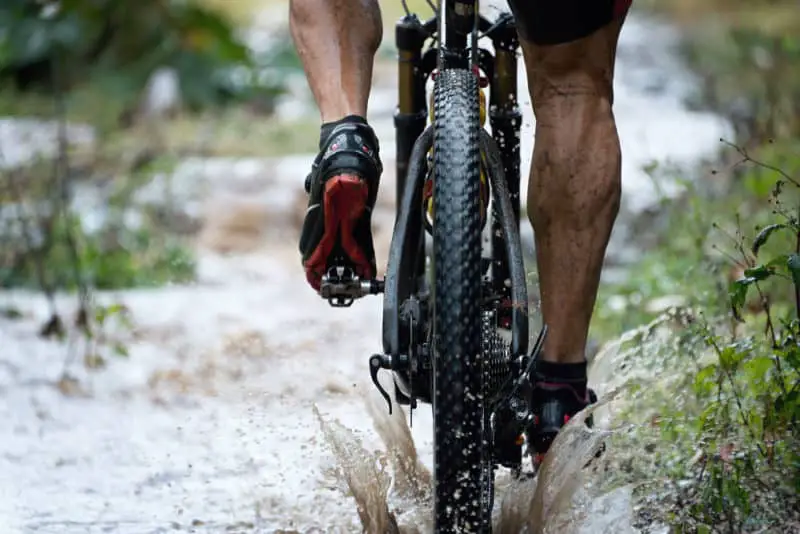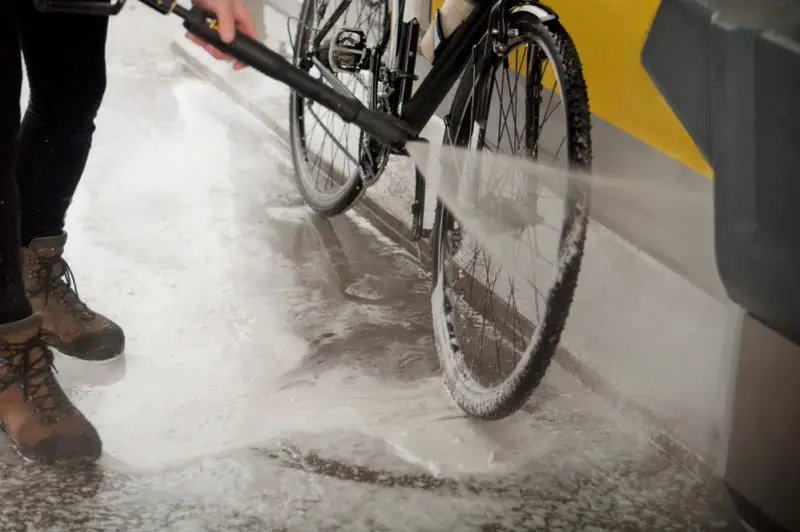We don’t all have the luxury of riding in warm, sunny conditions year-round. For many riders, these days are few and far between. Bike manufacturers certainly know this, and design their bike frames to withstand the elements.
But what about the other components that make your bike work…like bike chains for instance? How well do bike chains survive wet conditions? And what can you do to give your chain a fighting chance at lasting an entire riding season?
Find out below!
Is It Okay for a Bike Chain to Get Wet?
It is perfectly okay for your bike chain to get wet. They are built to withstand the rigors of poor riding conditions. However, your chain will rust if it’s left in wet conditions for an extended period. Failure to dry and clean your chain properly can cause significant rusting, even after only a few days.

This is something I experienced myself after a recent mountain bike trip to North Carolina. Being in the mountains without proper cleaning and maintenance gear, I was unable to give my bike the once over with a scrub brush like I usually do. After a weekend of riding in cold, wet conditions, I drove back home to discover my chain was severely rusted!
This surprised me, as I didn’t think it could happen in such a short period of time. But apparently it can…
Bike chains are made of steel: very strong, but prone to rust. Some bike chains are nickel-plated to prevent rust, but not all of them are. A ride in wet, muddy conditions won’t do any damage to your bike chain…it’s when you leave your chain wet and muddy that the problems start to occur.
Rust happens when metal faces prolonged exposure to oxygen and moisture (like when you don’t clean and dry your bike chain after a ride in wet conditions). Over time, rust can begin to weaken and degrade the metal, leaving it prone to breakage.
Cleaning and drying your bike chain (and the rest of your bike!) is a simple, effective way to prevent rust buildup, especially if you frequently ride in wet conditions.
Do You Need to Re-Lube a Bike Chain After Washing?

Bike lube’s job is to keep water, dirt, mud and other debris from getting caught up in your bike chain. Over time as it completes its task, the bike lube will dry up or wear off, and needs to be reapplied.
This is especially true after you wash your bike. Washing your bike helps remove debris, but it will also remove some of the lube you’ve coated the chain with. This isn’t a big deal, as long as you reapply after washing!
If washing your bike with a hose removes some chain lube, scrubbing your bike with a brush will remove almost all of it. But you should be scrubbing your bike, giving extra attention to the drivetrain (cassette, derailleur and chain). Debris buildup here will wreak havoc on your shifting and pedaling performance.
Once you’ve removed all remaining debris and properly dried your bike chain, it’s time to add lube. Check out the video below if you need a refresher on how to do this:
If you frequently ride in wet, muddy conditions and aren’t already using a chain lube made for wet conditions, it’s time to switch!
Dry lube is made for use in dry, dusty conditions. It’s perfectly capable of repelling dust and sand, and it’s thinner compound means it won’t gunk up your drivetrain…but the downside is that it’s easily washed off with water.
Wet lube uses a much thicker formula that can hold up to riding in very wet, snowy or muddy conditions. It’s much more effective at repelling debris, but can build up in your drivetrain and cause shifting issues if it isn’t cleaned out and reapplied once in a while.
Check out this article to learn more about the differences between wet and dry chain lube, as well as when you should consider each type.
As a general rule of thumb, the wetter and muddier your riding conditions, the more frequently you should be scrubbing your drivetrain and then reapplying wet lube once your chain is dry.
Can You Lube a Bike Chain When It’s Wet?
I mentioned above that you should reapply lube after you’ve cleaned and dried your bike chain.
But wet lube is…wet. So can you apply it to a wet chain without issue?
Whether you’re using wet or dry lube, your chain should be completely dry before applying it. Chain lube needs a dry surface in order to adhere to the chain and work its way in between all the links before it can do its job effectively.
Chain lube also needs a bit of time to set and dry for maximum effectiveness. Lube can’t dry on a wet surface! It will instead cling to the moisture on a wet chain and run right off or evaporate as the water dries. Neither scenario leads to any benefit for your shifting performance.
My advice?
Clean and dry your bike chain as soon as you get back from a ride. Once the chain is dry, apply the appropriate lube for your riding conditions. That way, the lube will have time to set before your next ride!
How to Properly Dry a Wet Bike Chain
To give chain lube the best chance at success, you’ll want to dry your bike chain as thoroughly as possible before applying it.
A great way to do this is to remove the chain completely. Doing this requires a small pair of needle-nose pliers or a master link removal tool to separate the chain at the master link. With the chain removed, you can thoroughly clean and dry it without the rest of your bike getting in the way.
While a chain breaker tool is great for removing and repairing damaged chain links, you should avoid using it simply to remove a working chain for cleaning. The pins holding the chain links together will begin to weaken if removed and reinstalled too frequently, which could result in the chain breaking during a ride.
With the chain removed, dry it with a microfiber cloth. You’ll want to use this kind of cloth so it doesn’t leave any of those little fibers or threads stuck in between the links of your chain: not only are these annoying, but they could negatively impact your chain’s performance.
If you’re in a pinch and don’t have any tools, dry the chain as best as you can with it still on your bike: hold the chain with a clean cloth and turn the pedals backwards to run the chain through the cloth until it’s dry.
Leave the bike in a cool, dry place until any remaining moisture has evaporated, then apply chain lube to the inside portion of the chain (the part that contacts the teeth of the cassette).
How to Protect a Bike Chain from Rain / Water
If wet conditions are the norm in your area, the number one thing you should be doing to protect your bike chain from rust caused by water exposure is using a wet lube. I’ve talked about the benefits of wet lube in the previous sections, but this is just another reminder to switch to wet lube if you haven’t already!
Now I understand you won’t be able to keep every drop of moisture away from your bike chain…and you don’t need to. Your bike will function just fine if it gets wet. But how can we stop water from doing long-term damage?
One way is by washing off your bike after each ride.
“Using water to protect my bike from water? That’s crazy!”
I know how it sounds, but not all water is as clean as the water that comes out of your hose. Groundwater can be contaminated with impurities like dirt, gravel and salt (especially if you ride in the winter). Salt will corrode your bike’s components and speed up the oxidation process that causes rusting. You want to get all of that off your bike as soon as possible.
Proper storage is also essential. You can clean and dry your bike down to the last bolt, but if you leave your bike chained outside exposed to rain and snow, you’re not doing it any good.
And don’t forget about humidity! It might not rain a lot, but if you live in a place where it’s very humid, the moisture in the air can do long-term damage to your bike’s metal components.
Find a cool, dry place where your bike can drip dry before your next ride.
And speaking of your next ride…
If you’re on a biking road trip, your bike will probably spend a lot of time in your car’s bike rack. Traveling with your bike will expose it much more severely to the elements, including road salt and debris kicked up by your own tires. This is especially true for those of us (like me) who use a trailer hitch rack.
Before putting your bike in the rack, spend a few minutes drying off your bike’s chain and other metal components. Even if you can’t wash them with clean water, wiping them down should keep the rust away until you can be more thorough. You can also wrap a towel or cloth around your bike’s chain to keep it dry during transportation.
You’ll never be able to completely avoid water, nor should you try to: it’s just part of the cycling experience! But these simple preventive measures can significantly increase the lifespan of your bike’s drivetrain, saving you a ton of money that you can put toward every cyclist’s favorite holiday: New Bike Day!
